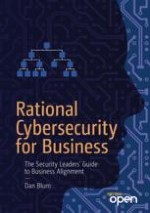Open Access 2020 | Open Access | Buch

Rational Cybersecurity for Business
The Security Leaders' Guide to Business Alignment
verfasst von: Dan Blum
Verlag: Apress
Open Access 2020 | Open Access | Buch

verfasst von: Dan Blum
Verlag: Apress
Use the guidance in this comprehensive field guide to gain the support of your top executives for aligning a rational cybersecurity plan with your business. You will learn how to improve working relationships with stakeholders in complex digital businesses, IT, and development environments. You will know how to prioritize your security program, and motivate and retain your team.
Misalignment between security and your business can start at the top at the C-suite or happen at the line of business, IT, development, or user level. It has a corrosive effect on any security project it touches. But it does not have to be like this.
Author Dan Blum presents valuable lessons learned from interviews with over 70 security and business leaders. You will discover how to successfully solve issues related to: risk management, operational security, privacy protection, hybrid cloud management, security culture and user awareness, and communication challenges.
This open access book presents six priority areas to focus on to maximize the effectiveness of your cybersecurity program: risk management, control baseline, security culture, IT rationalization, access control, and cyber-resilience. Common challenges and good practices are provided for businesses of different types and sizes. And more than 50 specific keys to alignment are included.
What You Will Learn
Improve your security culture: clarify security-related roles, communicate effectively to businesspeople, and hire, motivate, or retain outstanding security staff by creating a sense of efficacy
Develop a consistent accountability model, information risk taxonomy, and risk management framework Adopt a security and risk governance model consistent with your business structure or culture, manage policy, and optimize security budgeting within the larger business unit and CIO organization IT spend Tailor a control baseline to your organization’s maturity level, regulatory requirements, scale, circumstances, and critical assets Help CIOs, Chief Digital Officers, and other executives to develop an IT strategy for curating cloud solutions and reducing shadow IT, building up DevSecOps and Disciplined Agile, and moreBalance access control and accountability approaches, leverage modern digital identity standards to improve digital relationships, and provide data governance and privacy-enhancing capabilities
Plan for cyber-resilience: work with the SOC, IT, business groups, and external sources to coordinate incident response and to recover from outages and come back stronger Integrate your learnings from this book into a quick-hitting rational cybersecurity success plan
Who This Book Is For
Chief Information Security Officers (CISOs) and other heads of security, security directors and managers, security architects and project leads, and other team members providing security leadership to your business